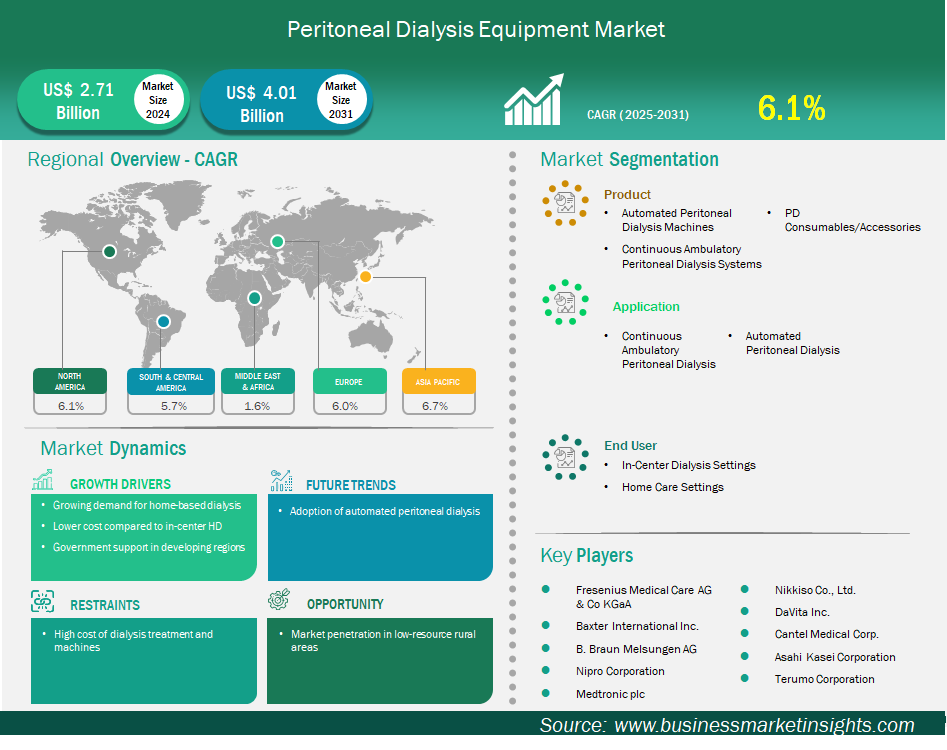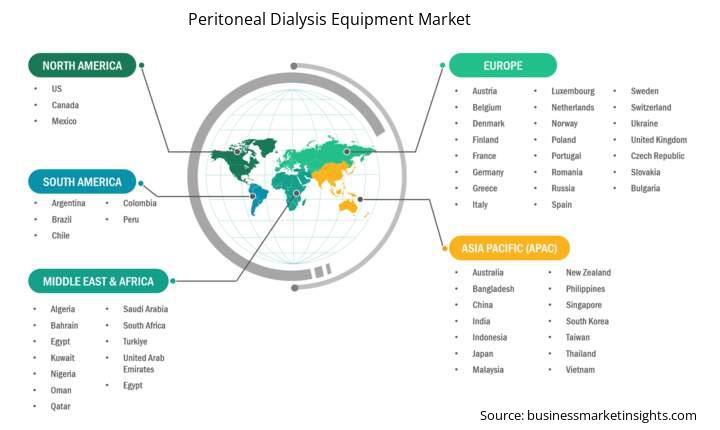Peritoneal Dialysis Equipment Market Outlook (2021-2031)
No. of Pages: 200 | Report Code: BMIPUB00031671 | Category: Life Sciences
No. of Pages: 200 | Report Code: BMIPUB00031671 | Category: Life Sciences
The peritoneal dialysis equipment market size is expected to reach US$ 4,093.52 million by 2031 from US$ 2,705.21 million in 2024. The market is estimated to record a CAGR of 6.6% from 2025 to 2031.
The global peritoneal dialysis equipment market is experiencing steady growth driven by growing demand for home-based dialysis, lower cost compared to in-center HD, and government support in developing regions. Peritoneal dialysis equipment encompasses automated peritoneal dialysis machines, continuous ambulatory peritoneal dialysis systems, and PD consumables/accessories. The worldwide peritoneal dialysis market is experiencing steady growth, attributed to government healthcare initiatives, reimbursement programs, and increasing patient's knowledge of the benefits of home dialysis, which have improved uptake.
Countries like India, China, and the United States are reporting higher rates of uptake as a result of cost-effectiveness and enhanced patient convenience. Additionally, the Advancing American Kidney Health initiative aims to have 80% of kidney transplant and home dialysis patients by 2025, affecting the PD equipment market positively. Recent feedback from the International Society of Nephrology (ISN) stated there was a global rise in acute kidney injury (AKI); 13.3 million globally, 11.3 million in developing countries annually, increasing the demand for peritoneal dialysis (PD) and subsequently the required equipment. Technological advancements such as biocompatible dialysate solutions, smart monitoring systems, portable peritoneal dialysis (PD) devices, and many other innovations are contributing to increased efficiency and improved patient outcomes. The emergence of artificial intelligence (AI) platforms assisting patient's just-in-time dialysis management and with remote monitoring has significantly reduced complications, enhanced personalized care for the patients.

Key segments that contributed to the derivation of the peritoneal dialysis equipment market analysis are product, application, and end user.
The growing demand for home-based dialysis, is a key factor leading the Peritoneal Dialysis equipment market forward. Health systems are shifting towards a more patient-centred healthcare delivery system that emphasizes cost, simplicity and ultimately performance - home dialysis, particularly peritoneal dialysis (PD) can provide flexibility and convenience as an alternative to facility-based treatment. PD is especially beneficial in this context as patients can perform it themselves at home rather than having to travel to the facility’s multiple times a week in order to receive their treatment while alleviating the isolation and separation from family that occurs with current method of care.
Another factor driving this trend is that innovations and growth of automated peritoneal dialysis (APD) machines are making it easier for patients to manage technology in home settings, with advancements in usability, portability and remote monitoring increasing ease of use and short and long-term assessment and intervention. The COVID-19 pandemic exacerbated this problem and made patients and health care professionals more aware of the risk to patients from facility exposure along with the need for resilient home-care models. More recently, healthcare institutions, insurers and governments have been supporting home-based delivery models through training, rebates, and reimbursement which collectively are providing further traction to the demand for peritoneal dialysis equipment across the globe.
The penetration of markets in low-resourced, rural areas is a unique growth opportunity for the peritoneal dialysis (PD) equipment market. In the developing world, and even in rural areas of the developed world, access to in-center hemodialysis is restricted due to lack of access to basic healthcare infrastructure, distance to suitable treatment spaces, and lack of qualified personnel. PD - especially continuous ambulatory peritoneal dialysis (CAPD) - is an effective, inexpensive alternative that requires no advanced technology and no continuous supervision from a qualified medical professional. PD is non-ambulatory and a good fit for rural areas, as PD can be performed at home when reliable access to a hospital is not feasible.
In the developing world particularly, governments and charitable organizations are promoting PD as a solution to provide equitable renal care to patients in-resource challenged environments. When accompanied by good education, training, and provision of basic PD starter kits, a company can become market-entry savvy and fulfil a major public health need at the same time. As awareness and diagnosis of chronic kidney disease (CKD) develop in this world, patients will continue to look for accessible and home-based treatment for CKD, and the market will create enormous growth opportunities for the equipment and providers.
The peritoneal dialysis equipment market is classified according to products into automated peritoneal dialysis machines, continuous ambulatory peritoneal dialysis systems, and PD consumables/accessories. The automated peritoneal dialysis machines segment led the market in 2024 and beyond. Hemodialysis refers to the removal of waste products, excess toxic substances, and excess fluid from the blood when the kidneys can no longer remove them from the blood. The Automated Peritoneal Dialysis (APD) is witnessing significant growth due to its convenience, improved patient compliance, and alignment with modern home healthcare trends. Unlike manual methods, APD uses a cycler machine to perform dialysis overnight while the patient sleeps, offering greater flexibility and minimal lifestyle disruption. Technological advancements—such as compact design, remote monitoring, and user-friendly interfaces—are making APD more accessible and safer for home use. Patients and healthcare providers increasingly prefer APD for its potential to enhance quality of life and treatment adherence. Furthermore, rising support from healthcare systems through training programs and reimbursement is accelerating its adoption, particularly in developed markets.
In terms of applications, the market is segmented into continuous ambulatory peritoneal dialysis, and automated peritoneal dialysis. The automated peritoneal dialysis segment had the largest market share in 2024. The growing elderly population and increasing prevalence of end-stage renal disease (ESRD) are further fueling demand for APD, as it reduces the burden of frequent hospital visits. APD also lowers long-term healthcare costs by enabling home-based management and reducing pressure on dialysis centers. As awareness and availability improve in emerging markets, APD is expected to gain traction globally as a preferred modality for peritoneal dialysis.
By end user, the market is segmented into in-center dialysis settings, and home care settings. The home care settings segment held the largest share of the market in 2024. This is due to the convenience, cost-effectiveness, and flexibility they offer to patients. Unlike hemodialysis, peritoneal dialysis can be performed by patients themselves at home, reducing the need for frequent hospital visits and enabling better quality of life. This modality supports patient independence, especially for those with mobility issues or residing in remote areas. Additionally, healthcare systems and insurers increasingly favour home-based therapies to reduce hospitalization costs, further driving the adoption of peritoneal dialysis in home care environments.
Peritoneal Dialysis Equipment Market Report Highlights
Report Attribute
Details
Market size in 2024
US$ 2.71 Billion
Market Size by 2031
US$ 4.09 Billion
Global CAGR (2025 - 2031) 6.6%
Historical Data
2021-2023
Forecast period
2025-2031
Segments Covered
By Product
By Application
By End User
Regions and Countries Covered
North America
Europe
Asia-Pacific
South and Central America
Middle East and Africa
Market leaders and key company profiles
The "Peritoneal Dialysis Equipment Market Size and Forecast (2021–2031)" report provides a detailed analysis of the market covering below areas:

The geographical scope of the peritoneal dialysis equipment market report is divided into five regions: North America, Asia Pacific, Europe, Middle East & Africa, and South & Central America. The peritoneal dialysis equipment market in Asia Pacific is expected to grow significantly during the forecast period.
The Asia Pacific peritoneal dialysis equipment market consists of China, Japan, India, South Korea, Australia, Bangladesh, New Zealand, Philippines, Singapore, Indonesia, Taiwan, Malaysia, Vietnam, and the Rest of Asia Pacific. The peritoneal dialysis (PD) landscape in the Asia Pacific is booming with increasing rates of chronic kidney disease, increased healthcare spending, and interest in home-based therapies, among other factors. PD activity has been most prominent in China, supported by initiatives like the National Dialysis Project, which aims to increase PD following patients' societal rights to treatment for end-stage renal disease, particularly in rural and at-risk communities. Japan is currently seeing considerable growth in PD in much of the country, fueled by an aging population and government support to facilitate home dialysis, such as subsidy support and research funding. In India, government-supported programs, like the Pradhan Mantri National Dialysis Programme, are raising awareness and increasing access to PD, particularly through public health care. Other markets across the Asia Pacific, like South Korea, Australia, Thailand, Indonesia, Vietnam, Malaysia, and the Philippines, are also increasing uptake of PD through cost-effective, patient-friendly methods as alternatives to in-centre hemodialysis. Future market growth is expected to continue to be supported by governmental policy, infrastructure support, and advanced PD technologies.
The peritoneal dialysis equipment market is evaluated by gathering qualitative and quantitative data post primary and secondary research, which includes important corporate publications, association data, and databases. A few of the key developments in the peritoneal dialysis equipment market are:
The Peritoneal Dialysis Equipment Market is valued at US$ 2.71 Billion in 2024, it is projected to reach US$ 4.09 Billion by 2031.
As per our report Peritoneal Dialysis Equipment Market, the market size is valued at US$ 2.71 Billion in 2024, projecting it to reach US$ 4.09 Billion by 2031. This translates to a CAGR of approximately 6.6% during the forecast period.
The Peritoneal Dialysis Equipment Market report typically cover these key segments-
The historic period, base year, and forecast period can vary slightly depending on the specific market research report. However, for the Peritoneal Dialysis Equipment Market report:
The Peritoneal Dialysis Equipment Market is populated by several key players, each contributing to its growth and innovation. Some of the major players include:
The Peritoneal Dialysis Equipment Market report is valuable for diverse stakeholders, including:
Essentially, anyone involved in or considering involvement in the Peritoneal Dialysis Equipment Market value chain can benefit from the information contained in a comprehensive market report.